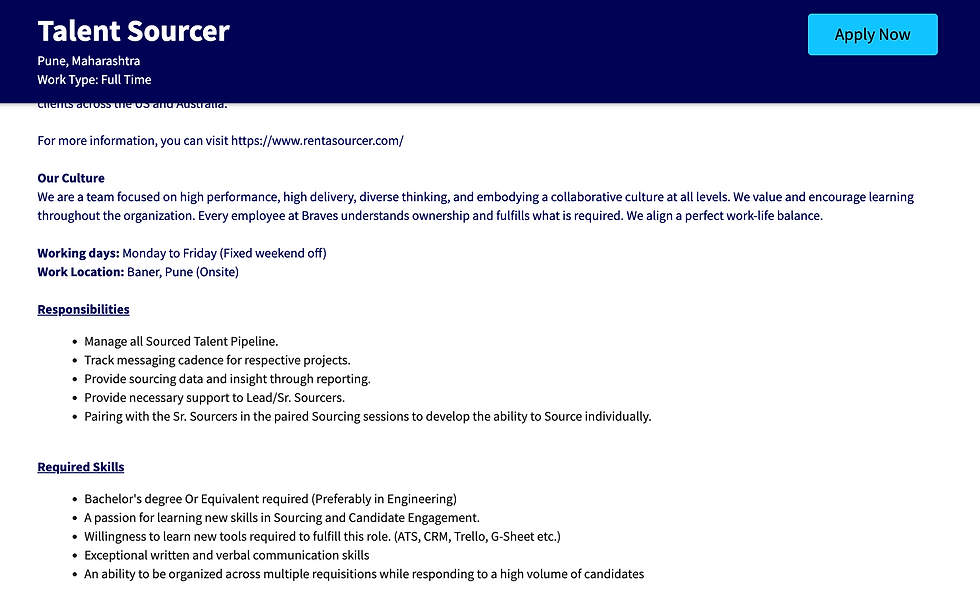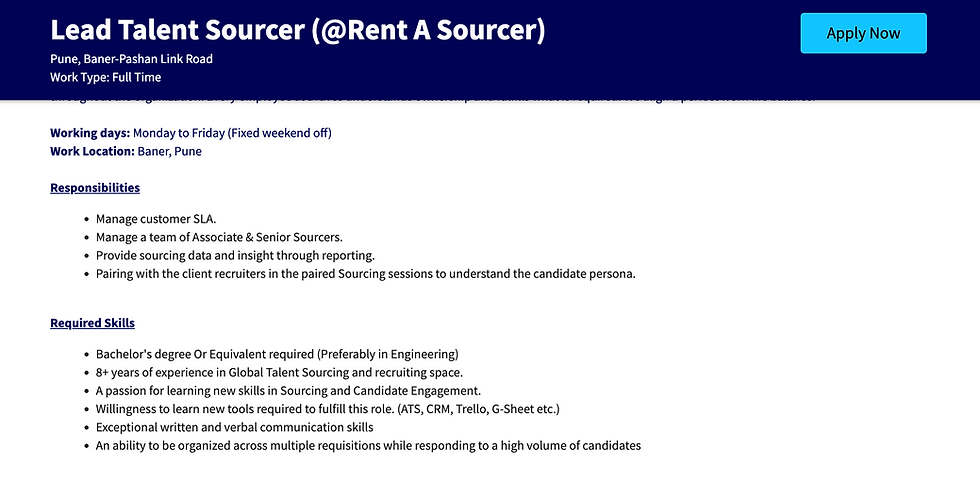Talent Sourcing Job Description: Complete Guide + Expert Template
- Pooja Pandit

- Sep 8, 2025
- 6 min read

What is the first step in the hiring process? If we ask this question, most recruiters would answer, 'interview!' or ‘resume submission. ’
However, the right answer is that it all starts with finding the right candidate worthy of the recruitment process.
It starts with a talent sourcer who does the groundwork for recruiters and sets the stage for successful hiring with high probability.
What is talent sourcing, and who is a talent sourcer?
Talent sourcing is a process of finding, attracting, and engaging potential candidates and converting them into applicants.
A talent sourcer is a person with a niche job role in the recruitment process that enables talent sourcing for organizations.
This blog aims to help you understand the talent sourcing job description in detail and what is the context of the role in modern hiring.
We have covered full job descriptions, modern responsibilities, nuanced insights, and company-size breakdowns, so you know what to write and look for when you are hiring a talent sourcer for your organization.
What makes the role of a sourcer more critical today?
Many might say it is just about supporting recruiters or filling the top of the funnel.
Today, talent sourcers are the engine of modern hiring. With more than 70% of the global workforce classified as passive candidates (LinkedIn), organizations cannot rely on job postings alone. Sourcers step in to connect with hidden talent, build relationships, and convert passive professionals into active prospects.
Their impact reaches beyond talent pipeline building. They strengthen diversity and inclusion efforts, enhance the candidate experience from the very first touchpoint, and shorten time-to-hire by delivering engaged, pre-qualified candidates to recruiters.
This is why the sourcer role is rising in importance today. They are not just support for hiring. They are a strategic force that influences employer branding, competitiveness, and long-term talent success.
Talent sourcing job description: Expert template
The job responsibilities of a talent sourcer changes seniority-level-wise. For example, here are three different levels of talent sourcing jobs, and how their description changes accordingly. So, we will provide you with a simple talent sourcing job description that can be your baseline, and you can edit it according to your needs.



Job Title & Reporting Line
Talent Sourcer
Reports to: Talent Acquisition Manager/Senior Recruiter
Job Summary
The Talent Sourcer plays a key role in building strong candidate pipelines by identifying, engaging, and nurturing talent. Working closely with recruiters and hiring managers, this role ensures that the right candidates are introduced into the hiring process at the right time.
Responsibilities
Source candidates through job boards, LinkedIn, social media, referrals, and networking.
Build and maintain talent pipelines for current and future hiring needs.
Conduct initial candidate outreach and engagement.
Collaborate with recruiters to understand job requirements and adjust sourcing strategies.
Maintain accurate data in the Applicant Tracking System (ATS).
Support diversity, equity, and inclusion (DEI) initiatives through targeted sourcing.
Required Skills & Qualifications
1–3 years of experience in talent sourcing or recruitment.
Proficiency in Boolean search, LinkedIn Recruiter, and job board sourcing.
Strong communication and relationship-building skills.
Familiarity with ATS/CRM tools.
Ability to multitask and manage priorities effectively.
Preferred Skills
Experience sourcing for niche or hard-to-fill roles.
Exposure to international or multi-market sourcing.
Knowledge of employer branding strategies.
Certification in talent sourcing or recruiting (e.g., AIRS, SHRM).
KPIs / Success Measures
Outreach response rate.
Submit-to-interview conversion.
Time-to-first qualified candidate.
Contribution to reduced time-to-hire.
Diversity pipeline contribution.
Growth & Career Path
Associate Talent Sourcer → Talent Sourcer → Senior Talent Sourcer → Lead Sourcer / Talent Acquisition Specialist.
Opportunity to specialize in strategic sourcing, DEI initiatives, or employer branding.
Potential to transition into full-cycle recruitment or talent strategy roles.
Pro-tip
Do not treat this JD as a template to copy and park in a folder.
Shape it for your industry. Adjust it for your company size.
Review it every year, because tools evolve and so do hiring needs.
And always link sourcing outcomes to business goals and DE&I.
That is when a JD stops being paper and starts being power.
Deepen expertise with nuanced role insights

Gone are the days of endless boolean strings and cold copy-paste outreach. Modern sourcers play at a different level. They set the tone for every candidate interaction, build pipelines that look like the real world, keep compliance tight, and use tech that feels almost futuristic.
Candidate experience audits
First impressions matter. Sourcers check every first hello. Is it warm? Is it human? Does it make the candidate lean in instead of scroll past? That one moment decides everything.
Diversity and inclusion outreach
Meeting inclusive hiring goals is currently the biggest obstacle for talent teams, cited by 44%, followed closely by lack of qualified candidates at 38%.This is the heart of sourcing today. Sourcers hunt for balance, not just volume. They dive into new networks, reach overlooked voices, and make sure pipelines are built with intention.
Compliance and data privacy
Let’s face it - trust is currency. Sourcers safeguard consent, follow GDPR and PDPA rules, and keep everything transparent. Candidates notice, and so does the brand.
AI and automation tools
Between 35% and 45% of companies have already adopted AI in their hiring processes with the AI recruitment sector projected to grow at 6.17% CAGR from 2023 to 2030. That signals how sourcing is increasingly tech-enabled and forward-thinking.This is where it gets exciting. Sourcers now use bots that chat, tools that map talent before roles even open, and forecasts that predict hiring needs like tomorrow’s weather.
The difference between the responsibilities of a talent sourcer in traditional and modern times
Aspect | Traditional Talent Sourcer | Modern Talent Sourcer |
Core Focus | Filling pipelines with active and available candidates | Building relationships with passive, niche, and diverse talent pools |
Sourcing Methods | Boolean search, job boards, resume databases | AI tools, social sourcing, talent communities, conversational sourcing |
Tools & Systems | Applicant Tracking System (ATS) management | Advanced CRMs, talent intelligence platforms, compliance tools |
Outreach | One-way outreach (emails, InMails) | Personalized, multi-channel engagement with candidate experience audits |
DE&I Contribution | Limited focus on diversity | Strategic DE&I sourcing and inclusive outreach campaigns |
Employer Branding | Rarely involved | Actively represents and amplifies the employer brand in sourcing interactions |
Compliance & Privacy | Basic record-keeping | Embedding GDPR, consent tracking, and ethical candidate data practices |
Strategic Insight | Minimal involvement in hiring strategy | Provides market intelligence and talent mapping for leadership decisions |
Skills & qualifications
Let’s break down the skills and qualifications that truly define a modern talent sourcer. Recruiters often assume it is just about knowing LinkedIn or running search strings. But, a sourcer, today, blends tech, people skills, and industry know-how into one sharp toolkit.
Technical skills: Comfort with ATS and CRM systems, Boolean search mastery, and fluency in specialized sourcing platforms.
Soft skills: Storytelling that turns a cold outreach into a warm conversation, sharp research instincts, and smooth collaboration with recruiters and hiring managers.
Industry knowledge: A sourcer who understands the nuances of specific industry, such as healthcare, tech, AI, or fintech will always deliver sharper pipelines than one who does not.
Certifications: Credentials like SHRM, AIRS, or LinkedIn Recruiter certification validate expertise and signal credibility in the field.
It is this mix of tools, communication, domain fluency, and proof of learning that separates an average sourcer from a standout one.
The role of a talent sourcer in different company sizes

A talent sourcer’s role does not look the same everywhere. It shifts with company size, moving from survival mode in startups to structured balance in mid-sized firms and finally to full-scale specialization in enterprises.
Small Companies/Startups
Here the sourcer is not just a sourcer. They are the recruiter, the networker, sometimes even the brand evangelist. The playbook is scrappy. Social networks, referrals, personal hustle. Every hire feels like shaping the DNA of the company. Culture fit is not a box to tick, it is survival.
Mid-Sized Companies
Now the sourcer steps into their own spotlight. The role gets sharper. Sourcing is not just filling roles, it is also building visibility. Employer branding and talent pipelining start to matter. Metrics kick in. Tools get heavier use. The sourcer becomes both hunter and storyteller.
Large Enterprises
Here the machine is massive and the sourcer is laser-focused. Specialized by region, by business unit, sometimes even by role type. Compliance is a must. AI tools run in the background. Talent mapping shapes entire strategies. Every move is tracked, measured, tied into workforce planning. It is sourcing on an industrial scale.
Read more about the complete recruitment team structure
Measuring Success: KPIs for Talent Sourcers
Measuring a sourcer’s success goes beyond counting candidates. The right KPIs reveal how effectively they turn outreach into real hires and business impact. Here are a few that matters.
Stage / Metric | What It Means |
Outreach → Response rate | How many candidates reply to your initial reach-out. |
Submit → Interview conversion | The percentage of submitted candidates that make it to interviews. |
Interview → Offer conversion | How many interviewed candidates get an offer. |
Offer → Accept % | The ratio of offers extended to offers accepted. |
Cost per SQP | The spend for each strong qualified prospect in the pipeline. |
Time-to-first qualified prospect | How fast you deliver the first solid candidate. |
Time-to-hire reduction | The overall drop in hiring cycle time driven by sourcing. |
Conclusion
A well-written talent sourcing job description is more than HR paperwork. It’s the foundation of stronger pipelines and faster hires. Use this template as your starting point, then adapt it with the tools, culture, and goals that make your organization unique.







